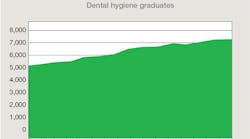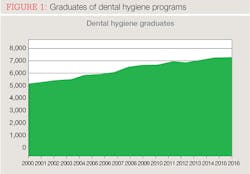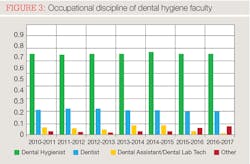ADA report provides interesting information about the profession’s training
Christine Nathe, RDH, MS
Dr. Alfred Fones educated the first dental hygienist, Irene Newman, and subsequently started the Fones School of Dental Hygiene. Interestingly, Fones School continues to educate dental hygienists today as part of the University of Bridgeport in Connecticut.1 When starting the school, Fones secured experienced professors and experts in medicine, basic sciences, public health, and dentistry from Yale, Harvard, Columbia, and the University of Pennsylvania to begin the new college discipline.2
Educating dental hygienists is important to the public’s health, and recently the American Dental Association (ADA) published the Survey of Allied Dental Education 2016-2017.3 This annual publication can be a great resource for the dental hygiene community. Especially important is the promotional advocacy for the scientific value of an educated dental hygiene workforce.
Graduates of dental hygiene programs have continued to grow throughout this decade (see related table). This information is interesting because we can see that there is still an increase in graduates, although this increase is happening at a slower rate. However, one piece of information that was not accounted for was the number of graduates who actually obtain a dental hygiene license and practice dental hygiene, but board examination passing rates were included from the previous year. Additionally, data revealed that of the students enrolled, 86% completed the dental hygiene program.
Another interesting bit of data that was collected is the types of programs that educate dental hygienists. Public colleges and universities continue to be the most common type of educational program for RDHs in the US.
Other interesting data included in the surveys is the occupational discipline of faculty members, which, not surprisingly, is dental hygiene. This means dental hygienists are being taught primarily by dental hygienists.
There are many other data resources, such as how much education typical dental hygienists have, how many prerequisites they have taken, financial aid information, and other demographics. Content hours of dental hygiene coursework is also included in some years’ data. This information can be used for reports on the need for educated dental hygienists in the workforce, and the need to provide an adequate supply of dental hygienists without oversaturation that can lead to unemployment and underemployment of RDHs.
Be proud of our profession and its history. Dental hygiene began as a college program and continues today!
CHRISTINE NATHE,RDH, MS, is director at the University of New Mexico, Division of Dental Hygiene, in Albuquerque, N.M. She is also the author of “Dental Public Health Research” (www.pearsonhighered.com/educator), which is in its fourth edition with Pearson. She can be reached at [email protected] or (505) 272-8147.
References
1. Fones AC. Mouth Hygiene. 3rd ed. Philadelphia, PA: Lea & Febiger; 1927:307–335.
2. Motley WE. History of the American Dental Hygienists’ Association 1923–1982. Chicago, IL: American Dental Hygienists’ Association; 1983.
3. Allied Dental Education Survey Dental Hygiene. ADA website. http://www.ada.org/en/science-research/health-policy-institute/data-center/dental-education. Accessed January 17, 2018.










